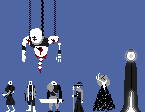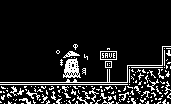Opening Crawl, A Brief History
Kenoma is in a somewhat unique position: at this point in the cycle, it is boring to watch. No major elements are being added or changed, the game is just being checked for defects. This will likely take a significant length of time in itself, and radio silence does not a successful release make. As such, instead of teasing development progress, these posts will wax over various details of the game, its design, and the history of such things.
To begin, I imagine it is best to explain where Kenoma has come from. It is a tangled mess of scrap, revived Old Ones, and ideas from the wider culture, as all works are. The concept has had four major forms, most of which were unnamed. For humor and organization, I will name them here: Redfire, Witchfire, Misfire, and Kenoma.
Something to understand before continuing: the core gameplay gimmick of the concept has always been a pair of “twinned worlds”. This is what unifies these ideas as variants of the concept, rather than as totally different works.
⠀
Redfire
The initial design for the project that would become Kenoma was slipshod and half-baked. Redfire was conceived as a small project to occupy time between semesters of college, and to return to programming as passion rather than as assigned labor. The concept, however, set my mind aflame. Things quickly spiraled.
(One of the only remaining vestiges of “Redfire” is this video of an early build. It never did get a graphical overhaul.)
Redfire’s final design intent before destruction is best conceptualized as The Red Book by way of Daggerfall. Jung’s cosmology of the mind is certainly interesting, and has enough convolution to choke a horse. An excellent choice for aspiring mystics. This combined with the strangely intoxicating and mazelike dungeons of Daggerfall would be able to create quite the heady mix of esoterics and confusion. It would be almost impossible to leave ‘unsolved’ for a particular kind of player.
There were two primary problems with Redfire. First: it was too much work. Creating a 3D environment dungeon-crawler with enough inside to really justify its jungian premise is a job for a team of at least five, not for one person. That is, if it intends to be finished in less than half a decade. Second: Jung’s Red Book is a compilation of the author’s worst pseudoscientific nonsense. Compelling or not, using it as a basis without deconstructing it comes with the bedrock assumption that it is in some way accurate, truthful, or worth considering in its intended psychological context. Which it isn’t. For these reasons, I abandoned this version of the concept.
⠀
Witchfire
Witchfire was a much shorter era of Kenoma’s design history. It had no real gameplay, and was primarily composed of visual mockups and design documents. After abandoning the core concept of Redfire, this was primarily an attempt to produce a new, less ‘icky’ design. Consider it a transition fossil.
Witchfire’s new direction was the initiation of several core principles that would make their way to the final product. The minimal pallet of the black-and-white entities seen in Redfire began their expansion to the environs here: changing from texture to flat-color. The narrative and setting were also put within the domain and whims of a god.

(Witchfire is named for the ‘tumblrcore’ deer skull creature pictured here, intended to be the god whose domain you were exploring. Its name was “Witchlord”.)
Witchfire was created in free time, and as such had little elaboration in terms of game-play structure. The core intent was to turn things into a more traditional “adventure game”, though little thought was given to it beyond that.
This was abandoned because it had very obviously grown beyond a manageable scope. The design began to shift towards a multi-archetype, rpg-adjacent structure similar to something like Diablo where you could be a wizard, knight, &c. An entire adventure game, structured to be completed in ways different enough to warrant character classes such as this, would not be something I could finish in a timely fashion.
⠀
Misfire
Of these concepts, Misfire is the least. No playable prototype was produced, no concept art was created. Yet it is one of the most consequential: it codified several of the core design structures that Kenoma would be molded by. The new core game-play would be along the lines of Zork in a 3D space, occupying a setting more like that of Dark Souls. Not in grimness or morosity, but in the shape of things. Confusion, interpretation, characters with adventures parallel to yours, and a depth built of true philosophy – no bogus nonsense like that of Jung.
The primary work of Misfire was research. I read several philosophical and religious works during the Misfire era, to gain a clearer understanding of the kinds of thought that would be needed to construct such a world as is in Dark Souls out of whole-cloth. My ultimate takeaway was to abandon the idea of creating something totally new to base the world on. It would be too much work for too little payoff. Instead, I could take context-free pieces of all I had wriggling within my head, and smash them together into something that harkened back to the originals with a unique twist.
As a result of this, the current framing of “two opposed worlds” took shape. A struggle between gods is a fine mythic story beat, and adding a philosophical disconnect between them would ground it, make it far easier for a player to choose a side for a good reason, and thus become invested.
Misfire was abandoned for the same core reason as Redfire and Witchfire: its scope was too large. It was not subject to much scope creep; instead, I realized that a 3D environment game was either going to be too short for what I wanted to do, or take too long to make. And Misfire was not of interest to me in 2D.
⠀
Kenoma
Finally, here is the game as it exists. A mostly nonviolent Zork by way of Dark Souls, mixed heavily with questions of philosophy and religion. Consisting of approximately 60,000 words, several sprites, and at least a few lines of code. The core of the player’s experience is their choice of immortality or mortality, an ever-compelling question to the existentialist within all of us.

(Kenoma’s one-bit visual style is primarily inherited from this image that I created far before the project began, which never truly left my mind.)
You can read the marketing copy and store pages for a clear understanding of what the game is. Primarily, this post has attempted to explain what the game was, and how it became what it is. By sharing this, I hope to in some way illuminate process of constant iteration, inspiration, and alteration in art – as well as to show that Kenoma is, if nothing else, a deeply premeditated work. Does that count for anything?
* * *
Please do not take the length of this post as an indication of the length of those to come. This is a much longer, more convoluted thing to explore than practically any other topic related to Kenoma. See you next week.
KENOMA on Steam: https://store.steampowered.com/app/2933260/Kenoma_Action_Without_Action/
KENOMA on itch: https://brukholevin.itch.io/kenoma-action-without-action
KENOMA press-kit [for journalists]: https://www.brukholevin.com/kenoma_presskit.html
Kenoma: Action Without Action
Journey into a strange and abstruse world to solve the question of mortality.
| Status | In development |
| Author | BrukhoLevin |
| Genre | Adventure, Interactive Fiction, Puzzle |
| Tags | 1-bit, 2D, Atmospheric, Female Protagonist, Multiple Endings, Singleplayer, Story Rich, Surreal |
| Languages | English, Chinese (Simplified) |

Leave a comment
Log in with itch.io to leave a comment.